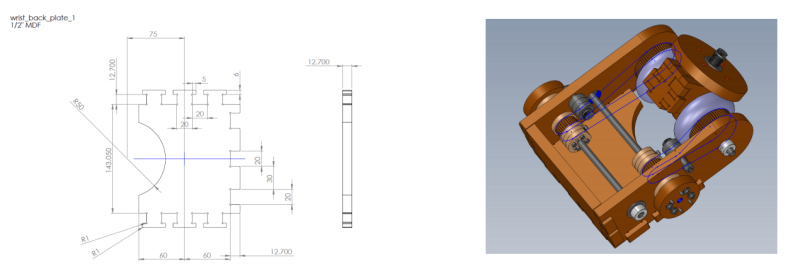Here on Hackaday, too often do we turn our heads and gaze at the novelty of 3D printing functional devices. It’s easy to forget that other techniques for assembling functional prototypes exist. Here, [Reuben] nails the aspect of functional prototyping with the laser cutter with a real-world application: a roll-pitch friction differential drive built from just off-the shelf and laser-cut parts!
The centerpiece is held together with friction, where both the order of assembly and the slight wedged edge made from the laser cutter kerf keeps the components from falling apart. Pulleys transfer motion from the would-be motor mounts, where the belts are actually tensioned with a roller bearing mechanism that’s pushed into position. Finally, the friction drive itself is made from roller-blade wheels, where the torque transferred to the plate is driven by just how tightly the top screw is tightened onto the wheels. We’d say that [Reuben] is pushing boundaries with this build–but that’s not true. Rather, he’s using a series of repeatable motifs together to assemble a both beautiful and complex working mechanism.
This design is an old-school wonder from 2012 uncovered from a former Stanford course. The legendary CS235 aimed to teach “unmechanically-minded” roboticists how to build a host of mechanisms in the same spirit as MIT’s How-to-make-almost-Anything class. While CS235 doesn’t exist anymore, don’t fret. [Reuben] kindly posted his best lectures online for the world to enjoy.
Heads-up: keep in mind that this video is actually only 3:45 minutes long.
















GAH Left speaker Only OMG PUNCH SCREEN SO HARD.
for nearly two hours.
Be fair – most of those 2 hours is a black screen with a logo, and no sound. WTF?
Also, although the lectures are posted online, they’re *horrible* quality!
The video is about 80% of the YouTube video size, sound quality is almost inaudible (many words are ambiguous), the video itself looks like it was shot through light fog, and it’s a lecture, not a presentation (ie – generally awful, video shows people instead of diagrams or action, poor vocal variety… a host of other problems).
Don’t bother viewing the lectures – they were probably excellent lectures, but the information is no longer available.
There might be some useful data here, at least for this one project:
https://sites.google.com/site/salisburyrobotics2/home/Courses/cs235/labs-and-final-project/lab-2-robot-wrist-using-belts-and-a-friction-differential
https://www.thingiverse.com/thing:2005695
Very interesting item. Dunno about the lectures.